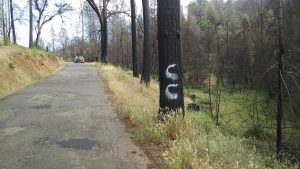Butte Fire Letter Sparks Shock And Questions
Mountain Ranch, CA – Calaveras County has been bombarded with calls after survivors that participated in the Right-of-Entry program received letters regarding the cost of chopping and hauling away dead trees in the Butte Fire footprint.
“The letter showed the amount that it cost CalRecycle to do their particular project, which was huge,” exclaims Calaveras County spokesperson Sharon Torrence. She adds, “Most people, myself included, once you see something that is shocking, (giggles) you don’t look any further because your mind is in shock mode, but it’s not a bill it’s a letter simply asking for insurance information.”
That information is need to pay back federal and state funds already used to pay for the work. As Torrence explains, “If you had no insurance or you had insurance that didn’t compensate for debris removal, there is no cost to you at all. If your insurance company indicated an amount for debris removal that is the portion that needs to be repaid because it’s a duplication of benefits. So, you just need to pay back that portion that has already been paid for by insurance.”
Due to the many questions regarding this letter, the county has put out a “Most Frequently Asked Questions” brochure, found here Butte Fire Debris Removal FAQs FINALfinal, to alleviate the public’s concerns.
Torrence also announced Phase I of the Burnt Hazard Tree Removal project has been completed. A total of 8451 trees, 82,882 cubic yards of logs and slash and 39,477 cubic yards of burned tree debris were hauled away. When the last tree was brought down in June, as reported here, Torrence noted that a second phase was need as an additional 1,500 trees had died during the work. She indicates, “Those trees will have to be removed because they still could present hazard to the traveling public. So, that will be considered Phase II. We’re waiting for an answer from FEMA (Federal Emergency Management Agency) and Cal OES (California Office of Emergency Services) whether or not they can be removed with the same regulations that were approved for the first phase.”
Torrence says currently the tree contractors are still once scene and available to do the work, so the county is hoping to get the approval “fast before they head to other jobs.” She adds the completion of Phase II is expected to take about three weeks.

